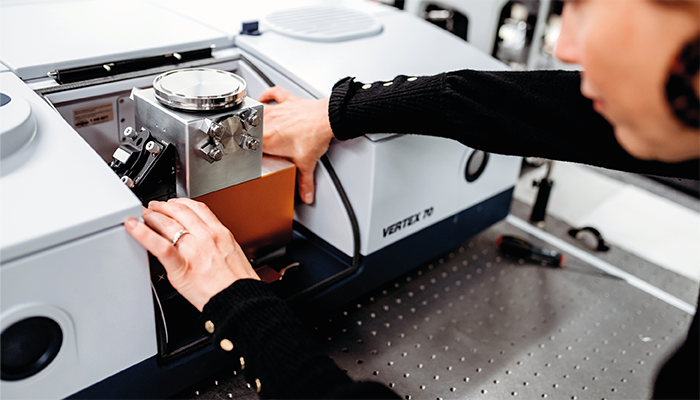
Credit: Romana Maalouf Photography.
The first infrared analyzer based on nanomechanical sensing for FTIR spectrometers
Produced by Invisible-Light Labs GmbH
EMILIE is a nanomechanical infrared analyzer combining nanoelectromechanical sensing (NEMS) with optomechanical infrared (IR) technology. Offering picogram-level sensitivity in the mid-to-far IR range, it provides a rapid, cost-efficient solution for analyzing nanoparticles and nanomaterials, such as ultrafine aerosols, nanoplastics, and nanopharmaceuticals.
Compatible with FTIR spectrometers, EMILIE streamlines nanomaterials analysis by reducing sampling times from hours to minutes and enabling bulk analysis without labor-intensive scanning. It fills a gap in routine monitoring, providing an accessible alternative to the complex, high-cost technologies typically used in this field.
What the judges say…
“The EMILIE is a nanomechanical infrared analyser that could help materials characterization with higher throughput and smaller samples.”
“Innovative combination of two advanced technologies for nanomaterial characterization.”
“Very innovative approach with high potential in miniaturized applications.”
How did you get together?
Josiane P. Lafleur and Silvan Schmid met as postdoctoral fellows at DTU Nanotech (Technical University of Denmark). They merged their two scientific fields of interest, analytical chemistry and nanomechanics, respectively, and co-founded Invisible-Light Labs GmbH, a spin-off from the Technical University of Vienna (TU Wien), to bring nanomechanical infrared spectroscopy to every analytical scientist’s laboratory. Two of Silvan’s PhD students at TU Wien, Niklas Luhmann and Hajrudin Bešić, soon joined them to develop the first EMILIE prototypes.
Was there a key breakthrough or major “eureka” moment during development?
At the origin, nanomechanical infrared spectroscopy required equipment not available in the standard analytical scientist’s laboratory, such as an infrared (IR) quantum cascade laser, a laser-Doppler vibrometer, and cleanroom-fabricated nanomechanical chips. The breakthrough was to make this very sophisticated technology widely accessible by making it compatible with existing FTIR spectrometers, such as Bruker’s Invenio and Vertex spectrometers, commonly found in analytical laboratories around the world. The result was EMILIE, the world’s first nanoelectromechanical system-based FTIR spectroscopy (NEMS-FTIR) tool.
Are you driven more by scientific curiosity or the desire to make an impact?
The development of EMILIE was driven by the desire to make a positive impact on the world we live in by enabling scientific breakthroughs in nanomaterial characterization, environmental monitoring, drug development, and material sciences, among others.
What big problems could analytical innovation help to solve over the next decade?
Detecting and characterizing nanoparticles remains a major challenge for analytical scientists.
With a picogram detection limit, EMILIE has the potential to play a crucial role in ensuring the safe and responsible use of nanomaterials and nanoparticles while providing valuable insights into their fundamental properties and behavior. The impact of EMILIE on environmental norms and regulations could be significant by providing a tool suitable for the routine monitoring and chemical characterization of airborne ultrafine particles (UFPs) and nanoplastics in water, among other nanoscale pollutants, for the first time. The versatility of the EMILIE nanomechanical sampling and sensing chips extends to the analysis of other analytes of interest, such as proteins, nanopharmaceuticals, and even thin films.




